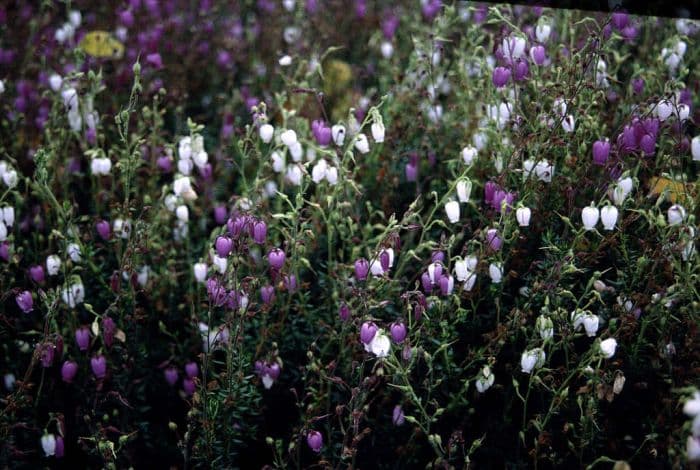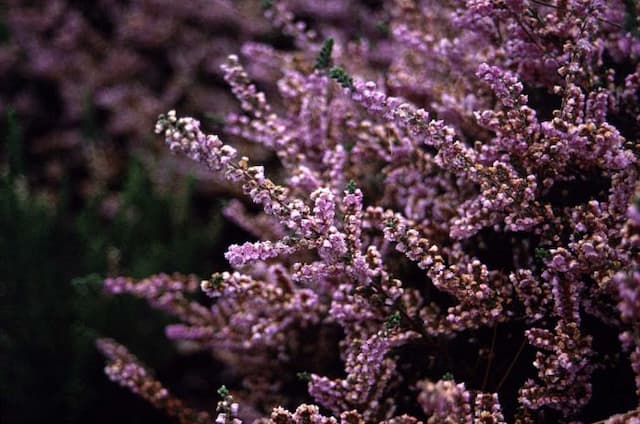Irish Heath Daboecia cantabrica 'Bicolor'

ABOUT
The Daboecia cantabrica 'Bicolor', commonly known as Irish heath, is a captivating evergreen shrub that is particularly noted for its distinctive flowers and foliage. The leaves of the Irish heath are small, narrow, and dark green, with a slightly glossy appearance that adds a well-polished look to the plant. What truly sets the 'Bicolor' variety apart is its two-toned blossoms, which are a remarkable feature throughout its blooming period. The flowers are bell-shaped, hanging gracefully in clusters that can cover the shrub, giving it a flamboyant display of color. They exhibit a blend of colors, typically with shades of pink and white that can appear to be quite vivid against the dark green backdrop of the foliage. These blossoms not only add a splash of color to gardens but are also a magnet for bees and butterflies who are attracted to their nectar. Irish heath tends to form a compact, mound-shaped bush, presenting a dense and bushy appearance which is perfect for use in a variety of garden settings, including borders, rockeries, or as a specimen plant. Its evergreen nature means that it provides interest in the garden year-round, while the contrast of flower color against the foliage makes it stand out during the flowering season.
About this plant
 Names
NamesFamily
Ericaceae
Synonyms
Irish Heath, St. Dabeoc's Heath, Bicolor Irish Heath
Common names
Daboecia cantabrica 'Bicolor'.
 Toxicity
ToxicityTo humans
The common name for Daboecia cantabrica 'Bicolor' is Irish Heath. There is limited information regarding the toxicity of Irish Heath to humans. Generally, it is not considered a toxic plant, and there are no well-documented cases of poisoning from ingestion. However, like with any plant not commonly consumed, it is still advisable to avoid ingesting it as individual sensitivities can vary and unintended effects might occur.
To pets
The common name for Daboecia cantabrica 'Bicolor' is also Irish Heath when referring to pets. Similar to the information available for humans, Irish Heath is not commonly known to be toxic to pets. There are no significant reports or studies indicating that this plant causes poisoning in animals. Nonetheless, pets should not consume this or any other ornamental plants as they can potentially cause gastrointestinal upset or indigestion due to the plant's fibrous material, or an individual pet could have a sensitive reaction. As always, it is prudent to monitor pets around plants and discourage them from nibbling on any non-food plants.
 Characteristics
CharacteristicsLife cycle
Perennials
Foliage type
Evergreen
Color of leaves
Green
Flower color
Mixed
Height
1-2 feet (0.3-0.6 meters)
Spread
2 feet (0.6 meters)
Plant type
Shrub
Hardiness zones
5
Native area
Europe
Benefits
 General Benefits
General Benefits- Attracts Pollinators: Daboecia cantabrica 'Bicolor' is known to attract bees and butterflies, providing a valuable nectar source for these beneficial insects.
- Ornamental Value: With its beautiful two-toned bell-shaped flowers, it adds aesthetic appeal to gardens and landscapes.
- Low Maintenance: This plant is relatively easy to care for, requiring minimal upkeep once established.
- Drought Tolerance: It can survive with limited water supply, making it suitable for xeriscaping or gardens in dry regions.
- Evergreen Foliage: The 'Bicolor' variety maintains its foliage throughout the year, offering continuous visual interest.
- Tolerance to Pests & Diseases: This plant often exhibits resistance to common pests and diseases, reducing the need for chemical interventions.
- Variability: It provides a range of colors in the garden throughout the flowering season, with blooms typically present from early summer to fall.
- Soil Adaptability: It can thrive in a range of soil types, although it prefers well-drained, acidic soils.
- Wildlife Habitat: Provides shelter and breeding spots for various insects, which can benefit the local ecosystem.
- Use in Landscape Design: Ideal for rock gardens, borders, containers, and alpine gardens, offering flexibility in garden design.
 Medical Properties
Medical PropertiesThis plant is not used for medical purposes.
 Air-purifying Qualities
Air-purifying QualitiesThis plant is not specifically known for air purifying qualities.
 Other Uses
Other Uses- Daboecia cantabrica 'Bicolor', also known as Irish heath, can be used as a natural dye source. The flowers and leaves may produce varying shades of colors when used in traditional fabric dyeing processes.
- Insect habitat support. Irish heath's dense growth can provide shelter for beneficial insects, supporting local biodiversity in the garden ecosystem.
- Photography subject. The striking contrast of the bicolor flowers can be an attractive subject for amateur and professional photographers alike, especially in macro photography.
- Craft projects. Its vibrant flowers can be dried and used in making bookmarks, greeting cards, or in scrapbooking, adding a touch of natural beauty to craft items.
- Floral arrangements. Fresh or dried, Irish heath can add texture and color contrasts to floral arrangements or potpourri mixes.
- Educational tool. The plant can serve as a living specimen for botany students learning about plant taxonomy and the Ericaceae family.
- Garden design. Due to its compact size and attractive foliage, Irish heath can be used in miniature or fairy garden designs for whimsical landscaping projects.
- Living mulch. When planted densely, Irish heath can act as a living mulch, conserving soil moisture and suppressing weeds.
- Border plants. Irish heath's neat growth habit and long blooming season make it an excellent choice for creating colorful, low-maintenance garden borders.
- Seasonal celebrations. The plant's flowers, which may bloom around certain holidays, can be used to create festive decor, such as natural wreaths or centerpieces.
Interesting Facts
 Feng Shui
Feng ShuiThe Irish Heath is not used in Feng Shui practice.
 Zodiac Sign Compitability
Zodiac Sign CompitabilityThe Irish Heath is not used in astrology practice.
 Plant Symbolism
Plant Symbolism- Endurance: Daboecia cantabrica 'Bicolor', commonly known as Irish heath, often symbolizes endurance due to its ability to thrive in harsh, rocky environments, reflecting the idea of persevering through tough conditions.
- Protection: Heath plants are often thought to offer protection, as they inhabit rough terrains, providing shelter and sustenance for wildlife, thus they can represent a safe haven or protection in symbolism.
- Solitude: Irish heath is sometimes found growing alone in its natural habitat, symbolizing solitude and the beauty of spending time in quiet reflection away from the bustle of society.
- Adaptability: With its capacity to adapt to poor soils and variable climates, the Irish heath represents adaptability and the ability to prosper despite changing and difficult environments.
 Water
WaterFor Irish Heath 'Bicolor', regular watering is key, especially during the growing season from spring to fall. Ideally, it should be watered thoroughly once every week, allowing the soil to become moderately dry between waterings. Each watering should provide enough water to soak the root zone—roughly up to 1 gallon for outdoor plants, with adjustments for rainfall, and less for smaller, container-grown plants, depending on pot size. During the winter months, reduce watering, allowing the soil to dry out more between applications, as the plant's growth slows down and water requirements decrease.
 Light
LightIrish Heath 'Bicolor' thrives best in full sun to partial shade conditions. It should be placed in a spot where it receives at least 4-6 hours of direct sunlight daily, while also providing some protection from the intense midday sun if located in a hotter area. Dappled shade for part of the day is beneficial in very bright, hot climates to prevent leaf scorch.
 Temperature
TemperatureIrish Heath 'Bicolor' is hardy and can withstand a wide range of temperatures, typically faring well from 20°F to 75°F. They can survive brief dips as low as 5°F but may need protection from frost. For the plant to flourish, aim for a daytime temperature between 60°F and 70°F, with cooler nighttime temperatures by about 10°F being ideal.
 Pruning
PruningPruning Irish Heath 'Bicolor' is done to maintain its shape, encourage bushier growth, and remove dead or spent flowers to stimulate new buds. It is best pruned after flowering, which typically means late spring or early summer. Cut back the flowered stems by about one-third, being careful not to cut into old wood that may not regenerate. A light trim annually is often enough to keep this plant looking its best.
 Cleaning
CleaningAs needed
 Soil
SoilIrish Heath (Daboecia cantabrica 'Bicolor') thrives in acidic soil with a pH from 5.0 to 6.0. A mix containing peat moss, sand, and loamy soil in equal parts ensures good drainage and aeration, which is essential for healthy root development. Regularly amend the soil with organic matter to maintain fertility and structure.
 Repotting
RepottingIrish Heath should be repotted every 2-3 years to refresh the soil and allow for growth. Over time, the soil can become compacted and nutrient-depleted, so repotting with fresh, acidic soil mix is recommended. Perform repotting in the spring when the plant is emerging from dormancy.
 Humidity & Misting
Humidity & MistingIrish Heath prefers moderate to high humidity levels. While it can tolerate some dryness, maintaining humidity between 40-60% is ideal for this plant, mimicking its natural habitat. Avoid placing it in areas with dry and hot air, which could stress the plant and lead to problems.
 Suitable locations
Suitable locationsIndoor
Provide bright, indirect light and acid soil.
Outdoor
Plant in partial shade, acidic soil, sheltered spot.
Hardiness zone
5-9 USDA
 Life cycle
Life cycleThe life of Daboecia cantabrica 'Bicolor', commonly known as Irish Heath, begins with germination, where seeds sprout in well-draining, acidic soil under cool, moist conditions. As a seedling, Irish Heath establishes a root system and grows its first shoots and leaves. The plant enters a vegetative stage where it develops a robust woody base and evergreen leaves. Flowering occurs typically in summer to autumn, presenting with white and pink blossoms that attract pollinators such as bees. After pollination, the flowers develop into small capsules that release seeds, completing the reproductive cycle. Eventually, Irish Heath reaches maturity and may live several years, during which it continues to grow and undergo cycles of flowering and seed production.
 Propogation
PropogationPropogation time
Early Spring
Daboecia cantabrica 'Bicolor', commonly known as Irish Heath, is often propagated by semi-ripe cuttings. This method is popular as it tends to yield reliable results. The optimal time for taking semi-ripe cuttings is in late summer to early fall when the new growth has begun to harden slightly. Cuttings should be about 3 to 5 inches long and must include a heel if possible. The cut end of the cutting is usually dipped in rooting hormone to encourage root growth and then placed in a well-draining rooting medium. The environment should be kept humid with moderate light but not direct sunlight, and at a consistent temperature, usually around 70-75 degrees Fahrenheit (21-24 degrees Celsius). Roots generally develop within several weeks, after which the new plants can be gradually acclimatized to less humid conditions before potting on or planting out.









